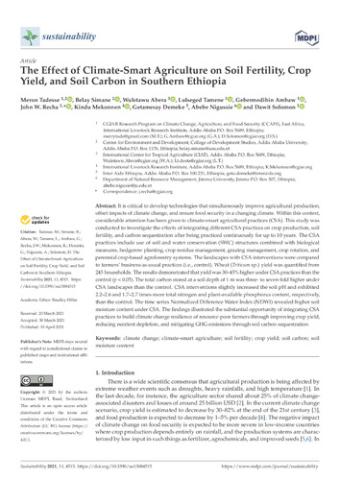Abstract
It is critical to develop technologies that simultaneously improve agricultural production,offset impacts of climate change, and ensure food security in a changing climate. Within this context,considerable attention has been given to climate-smart agricultural practices (CSA). This study wasconducted to investigate the effects of integrating different CSA practices on crop production, soilfertility, and carbon sequestration after being practiced continuously for up to 10 years. The CSApractices include use of soil and water conservation (SWC) structures combined with biologicalmeasures, hedgerow planting, crop residue management, grazing management, crop rotation, andperennial crop-based agroforestry systems. The landscapes with CSA interventions were comparedto farmers’ business-as-usual practices (i.e., control). Wheat (Triticumsp.) yield was quantified from245 households.The results demonstrated that yield was 30–45% higher under CSA practices than thecontrol (p 0.05). The total carbon stored at a soil depth of 1 m was three- to seven-fold higher underCSA landscapes than the control. CSA interventions slightly increased the soil pH and exhibited2.2–2.6 and 1.7–2.7 times more total nitrogen and plant-available phosphorus content, respectively,than the control. The time series Normalized Difference Water Index (NDWI) revealed higher soilmoisture content under CSA. The findings illustrated the substantial opportunity of integrating CSApractices to build climate change resilience of resource-poor farmers through improving crop yield,reducing nutrient depletion, and mitigating GHG emissions through soil carbon sequestratiom.

